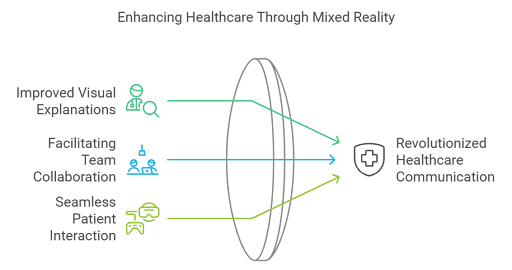How Mixed Reality is Transforming the Healthcare Industry
Mixed Reality Solution for Healthcare
A mixed reality solution for healthcare merges the physical and digital worlds, providing more engaging training, improved communication, and better patient experiences.
Healthcare professionals benefit from interactive 3D holograms and virtual scenarios that sharpen skills and build confidence in a risk-free environment. Teams can collaborate more effectively with real-time data overlays, ensuring more accurate decisions and superior patient care.
Patients gain a clearer understanding of their treatments and actively participate in their health journey. This heightened engagement often leads to improved outcomes and a more satisfying healthcare experience.
As mixed reality solutions continue to advance, their ability to revolutionize healthcare becomes ever more apparent. By bridging human care and cutting-edge technology, these solutions pave the way for a more innovative, effective, and connected healthcare future.
Revolutionizing Communication in Healthcare
Effective communication is vital in healthcare, not only between providers and patients but also among medical professionals. Mixed Reality enhances this in following ways:

Improved Visual Explanations
Doctors can use Mixed Reality tools to present complex medical information visually. For instance, holographic representations of human anatomy help convey surgical procedures, treatment plans, or disease progression, making it easier for patients to understand their conditions.
Facilitating Team Collaboration
Mixed Reality enables real-time collaboration among healthcare teams, regardless of their physical locations. Medical professionals can interact with 3D visualizations of patient data or collaborate on surgical strategies during virtual meetings, significantly improving outcomes.
Seamless Patient Interaction
By using Mixed Reality devices, doctors can explain complex procedures in an interactive way, reducing patient anxiety and enhancing trust.
Enhancing Medical Training and Education
Healthcare training has traditionally relied on lectures, textbooks, and limited hands-on practice. Mixed Reality transforms this process, making it more immersive and practical.
Realistic Simulations
Mixed Reality allows medical students and trainees to practice procedures in lifelike virtual environments. For example, aspiring surgeons can learn to perform intricate surgeries without any risk to real patients.
Interactive Learning Modules
MR integrates with learning platforms to create interactive, self-paced modules. These modules adapt to the user’s performance, offering personalized insights and ensuring a comprehensive understanding of the subject.
Continuous Skill Development
Mixed Reality technology can also be used to train existing professionals on the latest tools and procedures, ensuring they stay updated in an ever-evolving field.
Traditional Training Methods | Mixed Reality Training |
Theory-focused | Hands-on, interactive learning |
Limited access to resources | Unlimited, scalable virtual resources |
Time and location restrictions | Accessible anytime, anywhere |
Transforming Diagnosis and Treatment
Accurate diagnosis and effective treatment are at the core of healthcare. Mixed Reality enhances these processes by offering tools that provide deeper insights and precision.

Advanced Imaging and Visualization
Mixed Reality can layer patient data, such as MRI scans or X-rays, over the physical body, giving doctors a more detailed view. This helps in making precise diagnoses and planning treatments.
Minimally Invasive Procedures
Surgeons can use MR-assisted tools to visualize internal organs and tissues without making large incisions. This not only improves surgical accuracy but also reduces recovery time for patients.
Telemedicine Integration
Mixed Reality enhances telemedicine by allowing doctors to assess patients more thoroughly. MR-enabled devices can share real-time, three-dimensional visuals of patient conditions, making remote consultations more effective.
Streamlining Operational Efficiency
Beyond patient care, Mixed Reality is playing a pivotal role in improving operational workflows in healthcare settings.
Optimizing Facility Management
Hospitals and clinics can use Mixed Reality to create virtual models of their facilities, enabling better planning of layouts, equipment placements, and patient flow.
Inventory Management
MR applications can track medical supplies and equipment in real time, ensuring optimal inventory levels and reducing waste.
Empowering Decision-Making
Administrators can use Mixed Reality analytics to simulate different scenarios, from managing emergency situations to predicting patient influx during epidemics.
Flam Mixed Reality in Healthcare
Mixed Reality is transforming how healthcare providers build stronger brand presence while embracing new-age technology. By blending real and virtual environments, Mixed Reality enables immersive patient education campaigns, allowing individuals to better understand complex medical procedures or treatment options. This not only increases patient confidence but also helps healthcare organizations stand out as leaders in innovative care.
For medical professionals, Mixed Reality offers valuable training tools. Virtual scenarios let them practice surgical techniques or respond to emergency situations without any risk. This hands-on approach improves skill development, boosts confidence, and enhances overall patient safety.
In addition, Mixed Reality fosters collaboration across healthcare teams. By overlaying digital data and real-time patient information, it helps professionals make faster, more accurate decisions. As Mixed Reality continues to evolve, its ability to enrich patient experiences, improve training, and elevate healthcare presence is driving the industry forward.
Final Thoughts
Mixed Reality is undoubtedly shaping the future of healthcare, offering unparalleled opportunities to improve communication, training, diagnosis, and operational efficiency. As the technology matures, its applications are expected to expand further, transforming how healthcare providers deliver care and how patients experience it.
With innovative companies like Flam leading the charge, the integration of Mixed Reality into healthcare becomes a growing reality.
FAQs
How does Mixed Reality differ from virtual reality in healthcare?
Mixed Reality combines real-world and digital elements, enabling users to interact with both simultaneously. Virtual reality, on the other hand, immerses users entirely in a digital environment, cutting them off from the physical world.
Is Mixed Reality technology expensive to implement in healthcare?
While the initial costs may seem high, the long-term benefits, such as enhanced training, better diagnosis, and streamlined operations, often justify the investment.
Can MR be used in mental health treatments?
Yes, Mixed Reality has shown potential in mental health treatments, particularly in therapies for anxiety, PTSD, and phobias, by creating controlled, immersive environments.